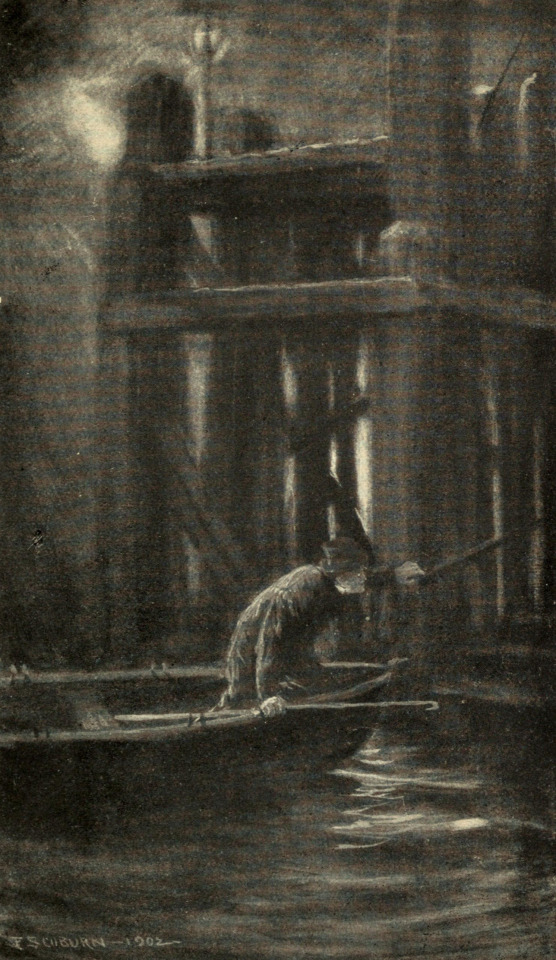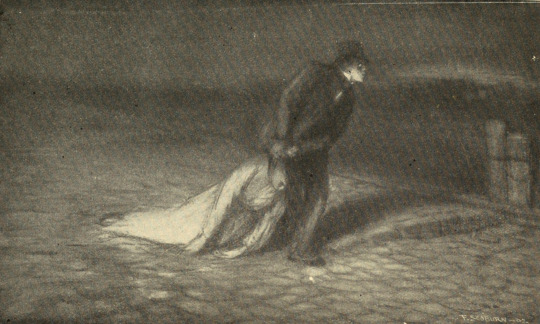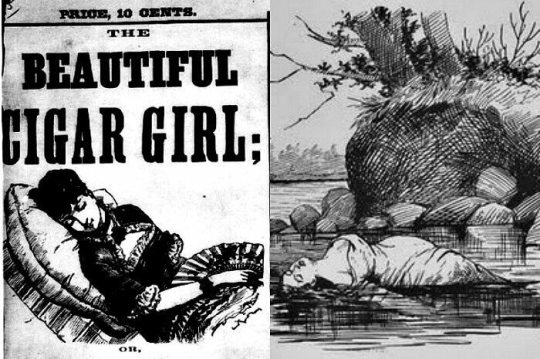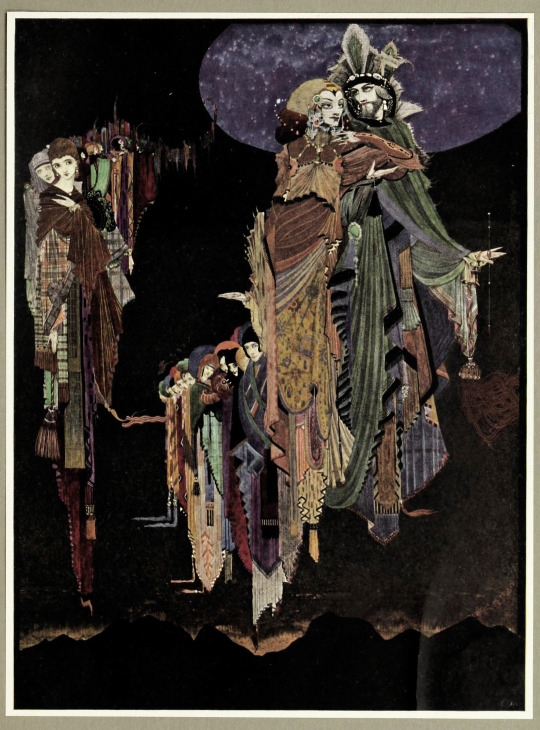#The Mystery of Marie Rogêt
Text


Frederick Simpson Coburn - The Mystery of Marie Rogêt, 1902.
~ A sequel to "The Murders in the Rue Morgue".
Tales and Poems of Edgar Allan Poe Vol.2
#frederick simpson coburn#the mystery of marie rogêt#edgar allan poe#illustration#illustrations#horror art
78 notes
·
View notes
Text
Reading prose of Edgar Allan Poe for the first time is such a beautiful experience. Reading short stories in order they were arranged in in a publibaction gave me first Berenice, Ligeia, Morella, The Fall of The House of Usher and the likes one gets a strong feeling of prevalent themes of death, being buried alive, transcending death in one way or another, all wrapped in a dark, gloomy and misty atmosphere.
Later King Pest mixes this mood with vulgar comedy while The Angel of the Odd and The Spectacles are full on comedic (The Spectacles are one of the funniest pieces of fiction I have ever read).
Then you read The Gold-Bug, The Murders in Rue Morgue, The Mystery of Marie Rogêt and The Purloined Letter all of which show you the skill of a brilliant mind (in the latter three cases mind of Monsieur Dupin) uncovering a mystery.
Something that surprised me the most was the sheer range of those stories, the mastery over both comedy and tragedy. To experience that range for the first time is to be overwhelmed by literary genius of the author.
#literature#edgar allan poe#gothic literature#ligeia#morella#the fall of the house of usher#king pest#the angel of the odd#the spectacles#the gold-bug#the murders in the rue morgue#the purloined letter#The Mystery of Marie Rogêt
2 notes
·
View notes
Text

my brain auto filled the two dashes so now God has come to visit Dupin and his friend in person instead of some generic police inspector
2 notes
·
View notes
Text
We gave the Future to the winds, and slumbered tranquilly in the Present, weaving the dull world around us into dreams.
Edgar Allan Poe, The Mystery of Marie Rogêt
0 notes
Photo

The Mysterious Murder of the Beautiful Cigar Girl
The mysterious murder of Mary Rogers, known in the penny press as the “Beautiful Cigar Girl,” in the summer of 1841 remains one of New York City’s most infamous unsolved cases. Even Edgar Allan Poe took a crack at solving it, yet while her ghost is said to have visited the numerous suspects that the press circled after the beautiful young lady’s death, the truth of the grisly crime is still as murky as the Hudson River waters where her corpse was found.
In 1838, John Anderson, who owned a tobacco shop on Broadway in Lower Manhattan, hired Mary Rogers to stand at his counter purely to allure gentleman customers. It worked, and the dark haired beauty who was described as ”ethereal and hypnotically pleasing” made Anderson’s Tobacco Emporium one of the most popular in town. It had a regular clientele of notable figures like Washington Irving and, it’s stated, Poe himself, as well as a cavalcade of journalists, which would help to get her gruesome end its high profile in the press.
One day in October of 1838, Rogers went missing. Two weeks later, she suddenly reappeared, and many thought that Anderson had staged the disappearance for publicity. Rogers’ adoring fans swarmed the shop, and she soon felt overwhelmed and left to work in her mother’s boarding shop. Yet in July of 1841, she went missing again, and this time two men on the shore of New Jersey spotted her floating near Sybil’s Cave.
Built in 1832 to connect to a natural spring, Sybil’s Cave once offered cool water to visitors to the Hoboken shore. The visitors have long vanished, but in 2007 a new gate was built in front of the manmade cave. It’s here that many believe Rogers was murdered, although how is still a matter of speculation. The bruises on her body and ligature on her throat suggested gang violence or a vengeful lover (one of her many suitors, perhaps). From when her swollen remains were pulled from the water, each new clue or suspect was breathlessly reported in the tabloids, and the public loved it, buying the papers in an unprecedented frenzy.
The attention, not surprisingly, took its toll on the people involved, particularly her fiancé Daniel Payne, who had a solid alibi, but was hounded by the press nonetheless. He was discovered near Sybil’s Cave dead from an apparent suicide by poison, with a note reading: “To the World - here I am on the very spot. May God forgive me for my misspent life.”
The rampant press also inspired Edgar Allan Poe, who had his own theories about the case. In his story “The Mystery of Marie Rogêt,” he not so subtly changed the details to Paris with a murder victim named Marie Rogêt. While his detective C. Auguste Dupin speculated on many suspects, he never settled on one, although Poe studiously kept updating the story with new evidence. It’s considered to be the first work of fiction that used a real murder as its source material.
One suspect, Anderson himself, was speculated to have had his amorous advances rejected by Rogers. Although he’s buried in Green-Wood Cemetery in Brooklyn, he died in 1881 in Paris, claiming to his last days that he was being tormented by her ghost. Payne also claimed to have seen the slender Rogers as a specter.
A later theory came from the deathbed of a tavern owner near Sybil’s Cave, who, after accidentally being shot by her son, gasped out that Rogers had actually died from a botched abortion. Some have theorized that this was done by the infamous Madame Restell, an early abortionist who practiced while it was still a felony. Restell would cut her own throat in her bathtub in 1878, and she’s now interred in Sleepy Hollow Cemetery.
It’s likely the mystery of who killed Mary Rogers that summer night will never be solved, although you can retrace her last steps yourself at the ruins of Sybil’s Cave, and wander to the final resting place of her employer in Green-Wood Cemetery, where he is perhaps resting in fitful peace with the ghost of the girl who once bewitched the city to his shop.
35 notes
·
View notes
Text

The Mysterious Murder of the Beautiful Cigar Girl
The mysterious murder of Mary Rogers, known in the penny press as the “Beautiful Cigar Girl,” in the summer of 1841 remains one of New York City’s most infamous unsolved cases. Even Edgar Allan Poe took a crack at solving it, yet while her ghost is said to have visited the numerous suspects that the press circled after the beautiful young lady’s death, the truth of the grisly crime is still as murky as the Hudson River waters where her corpse was found.
In 1838, John Anderson, who owned a tobacco shop on Broadway in Lower Manhattan, hired Mary Rogers to stand at his counter purely to allure gentleman customers. It worked, and the dark haired beauty who was described as ”ethereal and hypnotically pleasing” made Anderson’s Tobacco Emporium one of the most popular in town. It had a regular clientele of notable figures like Washington Irving and, it’s stated, Poe himself, as well as a cavalcade of journalists, which would help to get her gruesome end its high profile in the press.
One day in October of 1838, Rogers went missing. Two weeks later, she suddenly reappeared, and many thought that Anderson had staged the disappearance for publicity. Rogers’ adoring fans swarmed the shop, and she soon felt overwhelmed and left to work in her mother’s boarding shop. Yet in July of 1841, she went missing again, and this time two men on the shore of New Jersey spotted her floating near Sybil’s Cave.
Built in 1832 to connect to a natural spring, Sybil’s Cave once offered cool water to visitors to the Hoboken shore. The visitors have long vanished, but in 2007 a new gate was built in front of the manmade cave. It’s here that many believe Rogers was murdered, although how is still a matter of speculation. The bruises on her body and ligature on her throat suggested gang violence or a vengeful lover (one of her many suitors, perhaps). From when her swollen remains were pulled from the water, each new clue or suspect was breathlessly reported in the tabloids, and the public loved it, buying the papers in an unprecedented frenzy.
The attention, not surprisingly, took its toll on the people involved, particularly her fiancé Daniel Payne, who had a solid alibi, but was hounded by the press nonetheless. He was discovered near Sybil’s Cave dead from an apparent suicide by poison, with a note reading: “To the World - here I am on the very spot. May God forgive me for my misspent life.”
The rampant press also inspired Edgar Allan Poe, who had his own theories about the case. In his story “The Mystery of Marie Rogêt,” he not so subtly changed the details to Paris with a murder victim named Marie Rogêt. While his detective C. Auguste Dupin speculated on many suspects, he never settled on one, although Poe studiously kept updating the story with new evidence. It’s considered to be the first work of fiction that used a real murder as its source material.
One suspect, Anderson himself, was speculated to have had his amorous advances rejected by Rogers. Although he’s buried in Green-Wood Cemetery in Brooklyn, he died in 1881 in Paris, claiming to his last days that he was being tormented by her ghost. Payne also claimed to have seen the slender Rogers as a specter.
A later theory came from the deathbed of a tavern owner near Sybil’s Cave, who, after accidentally being shot by her son, gasped out that Rogers had actually died from a botched abortion. Some have theorized that this was done by the infamous Madame Restell, an early abortionist who practiced while it was still a felony. Restell would cut her own throat in her bathtub in 1878, and she’s now interred in Sleepy Hollow Cemetery.
It’s likely the mystery of who killed Mary Rogers that summer night will never be solved, although you can retrace her last steps yourself at the ruins of Sybil’s Cave, and wander to the final resting place of her employer in Green-Wood Cemetery, where he is perhaps resting in fitful peace with the ghost of the girl who once bewitched the city to his shop.
10 notes
·
View notes
Text
Edgar Allan Poe is credited with inventing detective fiction -- and explictly inspiring the Sherlock Holmes stories -- with his character C. Auguste Dupin. This character only appears in three stories, each of which has a philosophical quandary the character muses over.
In The Purloined Letter, he asks, "Why must mathematical reasoning be prioritized over poetics and imagination? Does it matter that an investigator is methodical if you he is unable to see things from his opponent's point of view?"
In The Mystery of Marie Rogêt, he asks, "Might crime journalism run the risk of obscuring the truth? Is the temptation of selling papers so great that the facts will be overwhelmed by an abundance of sensational theories?"
And in The Murders at the Rue Morgue, he asks, "What if a monkey got a knife? Wouldn't that be fucked up?"
31 notes
·
View notes
Text
Harry Clarke
The Colloquy of Monos and Una, 1923
'This illustration,' as David Caron has observed, 'comes from the expanded edition' of Tales of Mystery and Imagination (1923), that included 'eight colour plates for which Clarke was paid £100 by Harrap.' Three of these eight colour illustrations are now in the Collection of Crawford Art Gallery, with Marie Rogêt and The Fall of the House of Usher having been purchased previously in 1924. The Colloquy of Monos and Una was previously owned by the barrister Albert Ernest Wood (1873-1941) and his descendants Coincidentally, Wood was to introduce Clarke's friend and fellow artist, Seán Keating, to Seán Moylan (1889-1957), which resulted in the creation of the iconic painting, Men of the South (1921-22), also acquired by Crawford Art Gallery in 1924.

2 notes
·
View notes
Text
Edgar Allan Poe
My Rankings based his works as found in 'Complete Stories and Poems of Edgar Allan Poe' as published by Doubleday
Tales of Mystery and Horror
Ligeia
The Fall of the House of Usher
The Purloined Letter
The Murders in the Rue Morgue
The Cask of Amontillado
Berenice
The Masque of the Red Death
The Assignation
"Thou Art the Man"
The Tell-tale Heart
The Mystery of Marie Rogêt
The Facts in the Case of M. Valdemar
Hop-Frog
Morella
William Wilson
The Imp of the Perverse
The Black Cat
The Oblong Box
The Premature Burial
A Tale of the Ragged Mountains
Metzengerstein
The Gold-Bug
The Pit and the Pendulum
The Conversation of Eiros and Charmion
A Descent into the Maelström
MS. Found in a Bottle
The Man of the Crowd
6 notes
·
View notes
Text
The Mystery of Mary Rogers

July 13, 2022
Mary Cecilia Rogers was born in 1820 in Lyme, Connecticut, though there is no official birth record available. She was described as very beautiful, and she was an only child to her widowed mother. Her father had died in a steamboat explosion when Mary was 17 years old.��
Mary worked as a clerk in a tobacco shop owned by John Anderson in New York City, and at age 20 she was living in a boarding house that her mother run. It was said that John Anderson paid Mary a generous wage partly because of her beauty and how it would draw many customers to the shop.
On October 5, 1838, the newspaper the Sun reported that Mary had disappeared from her home. Her mother claimed that she found a suicide note which the coroner analyzed. The next day, October 6, the Times and Commercial Intelligence reported that the disappearance had been a hoax, that Mary had only gone to visit a friend in Brooklyn.
On July 25, 1841, Mary told her fiancé, Daniel Payne, that she was going to visit her aunt and other family. Only July 28, three days later, the police found Mary’s body floating in the Hudson River in Hoboken, New Jersey.
In the papers she was known as “the Beautiful Cigar Girl” and her death received national attention. The details suggested that she had been murdered or her body had been dumped in the river by abortionist Madame Restell after a failed abortion.
A few months later, with the inquest into Mary’s death still ongoing, her fiancé Daniel committed suicide by overdosing on laudanum while drinking heavily. A note was found on him where he died near Sybil’s Cave on October 7, 1841. The note read, “To the World - here I am on the very spot. May God forgive me for my misspent life.”
A popular theory was that Mary was the victim of gang violence. In November 1842, Frederica Loss swore that Mary’s death was the result of a failed abortion, though police refused to believe this.
Eventually the interest in Mary Roger’s death died down, as a lot of attention was going towards the unrelated murder case of Samuel Adams, which John C. Colt was convicted of in 1842.
Mary Rogers murder went unsolved, but was fictionalized by Edgar Allan Poe as “The Mystery of Marie Rogêt” in 1842. In Poe’s version of the story, the murder happened in Paris and the body was found in the River Seine. There’s never any murderer named in the story.
#UNSOLVED MYSTERIES#unsolved#unsolved murder#unsolved case#unsolved true crime#true crime#Crime#murder#homicide#new york
9 notes
·
View notes
Text
The Mystery of Marie Rogêt is set in a very weird city. At least if you were to ask my brain about it. The story is explicitly in Paris while footnotes explain the details of a real mystery in New York that inspired the story. Furthermore Dupin mentioning seawater hypothetically intruding into the river would be merely an interesting bit of trivia when discussing Seine in Paris but extremely down to earth relevant for Hudson in New York. Therefore, my brain imagined a weird, shapeshifting city that is both New York and Paris, both coastal and inland, with a shop that sells both tobbaco and perfume.
2 notes
·
View notes
Text
Going to start documenting all I’m reading. Just finished The Murders in the Rue Morgue, The Mystery of Marie Rogêt, and The Black Cat - all Poe short stories. Enjoyed the Murders in the Rue Morgue most of the three. Today started If We We Villains by M.L. Rio - fantastic so far.
7 notes
·
View notes
Text
Experience has shown, and a true philosophy will always show, that a vast, perhaps the larger, portion of truth arises from the seemingly irrelevant.
Edgar Allan Poe, The Mystery of Marie Rogêt
0 notes
Photo

“Experience has shown, and a true philosophy will always show, that a vast, perhaps the larger, portion of truth arises from the seemingly irrelevant.” ― Edgar Allan Poe, The Mystery of Marie Rogêt ➡️ @jordanv_fl inspiration vip Robert Ovette Brown, CEO Banda Television
#bandatelevision#puropincheparty#purobailando#purobailes#purosbailes#purobaileperron#bailesmexicanos#baileschingones#bailes#huapangos#huapango#wepa#cumbiawepa#zapateado#jaripeobaile#quebradita#quinceañera#quince
Dr.
0 notes
Text
Fortunate Son
`
FORTUNATE SON
#poem #poetry
#blogging
#mystery
- - - >
Let’s see
how shall we begin
to describe the fortunate son
It’s impossible they say
a trick question
the description itself but a
mystery
like who killed Marie Rogêt
In the end
there is no such thing
except for a brief moment in human
history
that maybe just maybe
he was the boy next door
voted mostly like to become
an unsolved serial…
View On WordPress
1 note
·
View note